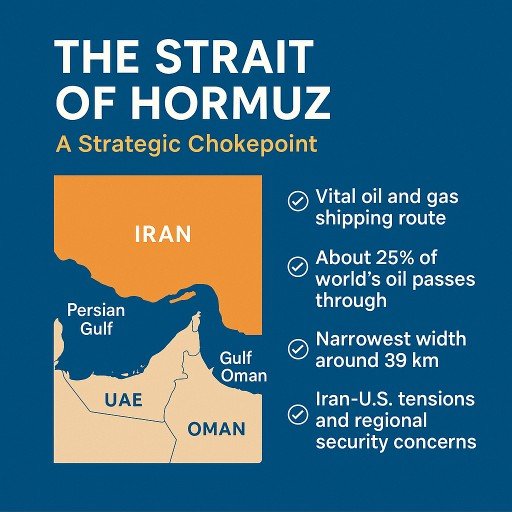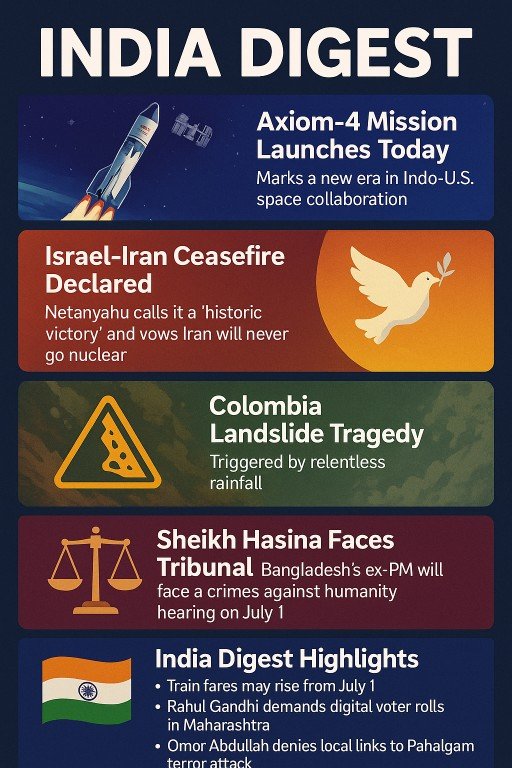Introduction
The Strait of Hormuz, a narrow waterway connecting the Persian Gulf to the Gulf of Oman, is one of the world’s most critical maritime chokepoints. For Indian Administrative Service (IAS) aspirants, understanding its strategic, economic, and geopolitical significance is essential, as it frequently appears in questions related to international relations, energy security, and global trade in the UPSC Civil Services Examination. This blog explores the Strait’s importance and strategic significance, its implications for India, and key issues for IAS preparation.
Geographical and Strategic Importance
- Location: The Strait of Hormuz lies between Iran to the north and the United Arab Emirates and Oman’s Musandam Peninsula to the south. It is approximately 167 km long, with its narrowest point just 39 km wide.
- Chokepoint Significance: It is the only sea passage from the Persian Gulf to the open ocean, making it a vital artery for global oil and liquefied natural gas (LNG) trade. About 25% of the world’s oil and 30% of its LNG pass through this strait.
- Navigational Constraints: The strait has two navigable lanes, each 3 km wide, separated by a 2-km safety zone, making it vulnerable to disruptions.
UPSC Relevance: Questions on maritime chokepoints, global trade routes, and their strategic control are common in Prelims and Prelims (GS-II: International Relations).
Economic Importance
- Global Energy Supply: Nearly a fifth of the world’s oil globally (17.2 million barrels per day) and a significant portion of LNG transits through the strait, supplying major economies like India, China, and Japan.
- Impact of Disruptions: Any closure or disruption, such as Iran’s threats to block the strait amid tensions with Israel or Western sanctions, could spike oil prices globally, potentially reaching $100 per barrel.
- Shipping and Trade: The strait accommodates oil tanker’s, container ships, and naval vessels, making it a critical node in international trade.
Geopolitical Dynamics
- Iran’s Role: Iran’s coastline is overlooks the strait for over 100 nautical miles, and it possesses missiles, drones, and naval capabilities to potentially disrupt traffic. Iran has historically threatened IRIS to close the strait in response to sanctions or conflicts, such as the 2018 U.S. withdrawal from the JCPOA.
- Regional Tensions: The strait has been a flashpoint for Iran-U.S. confrontations, including Iran’s seizure of commercial vessels and GPS jamming incidents affecting navigation.
- International Response: Western nations, through missions like the EU’s EMASoH, deploy naval assets to ensure freedom of navigation. India’s Operation Sankalp’s (2019) also safeguarded Indian vessels in the region.
- Island Disputes: Iran’s control over islands like Abu Musa, Greater Tunb, and Lesser Tunb, claimed by the UAE, adds to regional tensions.
UPSC Relevance: Geopolitical conflicts and India’s diplomatic balancing act are critical for GS-II (Bilateral and Regional Groupings).
Implications for India
- Energy Security: India imports over 85% of its oil, with a significant portion from Middle Eastern countries like Saudi Arabia, Iraq, and the UAE, transiting through the strait. Disruptions could lead to supply shortages, inflation, and economic strain.
- Economic Impact: Rising oil prices and higher shipping costs due to rerouting (e.g., via the Cape of Good Hope) could increase freight costs by 20%, affecting India’s trade.
- Strategic Interests: India’s Chabahar Port, located near the strait, provides an alternative trade route to Afghanistan and Central Asia, bypassing Pakistan. Its strategic value is enhanced amid Strait of Hormuz tensions.
- Indian Diaspora: Over 66% of India’s 1.34 crore NRIs reside in the Middle East, and their safety is a priority during regional conflicts.
- Naval Presence: India has expanded its naval operations in the Western Indian Ocean, conducting anti-piracy missions and promoting maritime domain awareness to secure its interests.
UPSC Relevance: India’s energy security, diaspora safety, and strategic projects like Chabahar are key for GS-III (Infrastructure and Security) and GS-II (International Relations).
Recent Developments (2025)
- Iran-Israel Conflict: Israeli airstrikes on Iranian targets in 2025, under “Operation Rising Lion,” and Iran’s retaliatory “Operation True Promise 3,” have raised fears of strait closure, spiking oil prices by 7-9%.
- GPS Jamming: Widespread GPS interference near Iran’s Bandar Abbas port has disrupted 970 ships daily, posing risks to safe navigation.
- Tanker Collision: A collision between oil tankers Front Eagle and Adalynn in June 2025, attributed to GPS jamming, underscores the strait’s vulnerabilities.
- Iran’s Threats: Iranian officials, including MP Esmail Kosari, have signaled plans to close the strait in response to Israeli attacks, though experts argue Iran’s own oil exports (65% of government revenue) make this unlikely unless its infrastructure is severely damaged.
UPSC Relevance: Current affairs related to West Asian conflicts and their global impact are crucial for Prelims and Mains (GS-II and GS-III).
Challenges and India’s Response
- Diplomatic Balancing: India maintains ties with both Israel and Iran, navigating their conflict while protecting strategic interests like Chabahar.
- Alternative Routes: India is investing in the International North-South Transport Corridor (INSTC) via Chabahar to reduce dependence on the strait.
- Energy Diversification: India is exploring alternative energy sources and suppliers to mitigate risks from strait disruptions.
- Maritime Security: Through operations like Sankalp, India enhances its naval presence to secure its vessels and trade routes.
UPSC Relevance: India’s foreign policy, energy diversification, and maritime security strategies are important for GS-II (International Relations) and GS-III (Security).
Multiple Choice Questions (MCQs) for IAS Prelims
- Which of the following countries border the Strait of Hormuz?
A) Saudi Arabia, UAE, Iran
B) Iran, Oman, UAE
C) Qatar, Bahrain, Iran
D) Iraq, Oman, UAE
Answer: B) Iran, Oman, UAE
Explanation: The Strait of Hormuz is bordered by Iran to the north, Oman’s Musandam Peninsula, and the UAE to the south. - What percentage of the world’s oil supply transits through the Strait of Hormuz?
A) 10%
B) 25%
C) 50%
D) 75%
Answer: B) 25%
Explanation: Approximately 25% of global oil and 17.2 million barrels per day pass through the strait. - Which Indian operation was launched to secure vessels in the Strait of Hormuz region?
A) Operation Raahat
B) Operation Sankalp
C) Operation Samudra Setu
D) Operation Sukoon
Answer: B) Operation Sankalp
Explanation: Launched in 2019, Operation Sankalp ensures the safety of Indian vessels in the Persian Gulf and Strait of Hormuz. - Which port, developed by India, is strategically located near the Strait of Hormuz?
A) Kandla Port
B) Chabahar Port
C) Mundra Port
D) Jawaharlal Nehru Port
Answer: B) Chabahar Port
Explanation: Chabahar Port in Iran provides India access to Afghanistan and Central Asia, bypassing Pakistan. - Which of the following islands in the Strait of Hormuz is disputed between Iran and UAE?
A) Qeshm Island
B) Abu Musa
C) Kish Island
D) Larak Island
Answer: B) Abu Musa
Explanation: Abu Musa, along with Greater and Lesser Tunb, is controlled by Iran but claimed by the UAE.
Tips for IAS Aspirants
- Conceptual Clarity: Understand the strait’s geography, strategic role, and economic significance. Use maps to visualize its location and chokepoint status.
- Current Affairs: Follow developments like the Iran-Israel conflict, GPS jamming, and India’s Chabahar project. Refer to reliable sources like The Hindu, Indian Express, and PIB.
- Linkages: Connect the strait to broader topics like energy security, India’s diaspora, and maritime security for Mains answers.
- Answer Writing: Practice questions like:
- “Discuss the strategic importance of the Strait of Hormuz and its implications for India’s energy security.” (GS-II)
- “Analyze the geopolitical tensions surrounding the Strait of Hormuz and India’s response to safeguard its interests.” (GS-II)
- MCQ Practice: Use the above MCQs to test your knowledge and refer to standard UPSC Prelims resources like Laxmikanth and Spectrum for additional questions.
Conclusion
The Strait of Hormuz is a critical global chokepoint with profound implications for India’s energy security, economy, and foreign policy. For IAS aspirants, mastering its strategic and geopolitical dimensions, supplemented with current affairs and practice MCQs, is vital for both Prelims and Mains. By leveraging reliable sources and interdisciplinary linkages, aspirants can craft comprehensive answers and excel in their UPSC preparation.
Stay tuned for more UPSC-focused blogs to ace your preparation!



